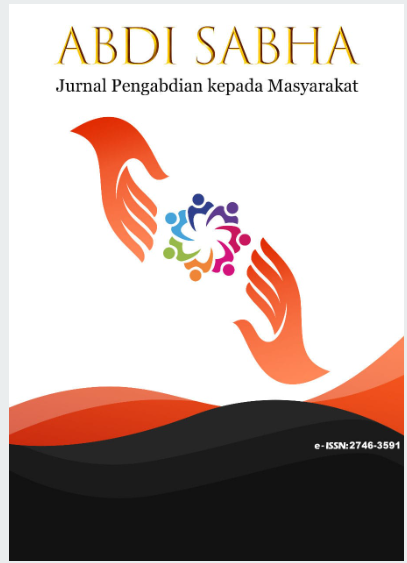Optimalisasi Produk Mocaf melalui Diversifikasi dan Inovasi Alat Produksi di Desa Pangebatan
DOI:
https://doi.org/10.53695/jas.v6i3.1287Keywords:
Cassava, mocaf, derivative products, digital marketingAbstract
Pangebatan Village has abundant natural resources, namely cassava. Processing cassava into Mocaf flour is one of the innovations that has been carried out, but it turns out that this does not make mocaf flour sell well in the market so that further processing is needed into derivative products that have high selling power including noodles, brownies, and cookies, but limited tools are a factor inhibiting the processing of mocaf flour. In addition, the lack of Human Resources to carry out promotion and marketing is something that needs serious attention. The Lecturer Team of Amikom Purwokerto University together with the PKK Mothers of Pangebatan Village carried out community service activities with the aim of solving several of these problems through the provision of tools to training in making derivative products, namely noodles, brownies, and cookies to digital marketing training to help promote and market products. The Lecturer Team and Students routinely monitor and evaluate community service activities to ensure the right solution for partners, encourage sustainable production of mocaf derivatives by the PKK Mothers of Pangebatan Village to improve family economy, and ensure the continuity of product promotion and sales. Community service activities in 2025 are funded by the Ministry of Education, Culture, Research and Technology as one form of the Tri Dharma of Higher Education to help with the problems of the surrounding community.Downloads
References
Dianingrum, Melia, Zanuar Rifai, Santi Dwi Astuti, and Nur Aini. 2023. “Pengembangan Produksi Pangan Non Terigu Untuk Meningkatkan Kualitas SDM Di Desa Pangebatan Karanglewas Banyumas.” Prosiding Seminar Nasional LPPM UNSOED 14: 116–20.
Febriyantoro, Mohamad Trio, and Debby Arisandi. 2018. “Pemanfaatan Digital Marketing Bagi Usaha Mikro, Kecil Dan Menengah Pada Era Masyarakat Ekonomi ASEAN.” Jurnal Manajemen Dewantara 1(2): 61–76. http://ejournal.stiedewantara.ac.id/index.php/JMD/issue/view/32.
Hapsoro, Bayu Bagas, Palupiningdyah, and Achmad Slamet. 2019. “Peran Digital Marketing Sebagai Upaya Peningkatan Omset.” Jurnal Pengabdian Masyarakat 23(2): 117–20.
Irfani, Hadi, Fitri Yeni, and Rika Wahyuni. 2020. “Pemanfaatan Digital Marketing Sebagai Strategi Pemasaran Pada Ukm Dalam Menghadapi Era Industri 4.0.” JCES (Journal of Character Education Society) 3(3): 651–59. https://journal.ummat.ac.id/index.php/JCES/article/view/2799/pdf.
Ishartono, and Santoso Tri Raharjo. 2023. “Sustainable Development Goals (SDGs).” Dictionary of Ecological Economics: Terms for the New Millennium 0042: 526–27.
Lestari, Putri Indah, Bernadette Robiani, and Sukanto Sukanto. 2023. “Kemiskinan Ekstrem, Ketimpangan Dan Pertumbuhan Ekonomi Di Indonesia.” EKOMBIS REVIEW: Jurnal Ilmiah Ekonomi dan Bisnis 11(2): 1739–52.
Madaliyah, Mihda, and Syifa Rohmah. 2016. “Upaya Pengentasan Kemiskinan Di Kota Medan.” At-Tawassuth 1(1): 24–44.
Mandal, Pinaki. 2017. “Understanding Digital Marketing Strategy.” International Journal of Scientific Research and Management 5(06): 5428–31.
Purwanto, Erwan Agus. 2007. “Mengkaji Potensi Usaha Kecil Dan Menengah (UKM) Untuk Pembuatan Kebijakan Anti Kemiskinan.” Jurnal Ilmu Sosial dan Ilmu Politik 10(3): 295–324.
Additional Files
Published
How to Cite
Issue
Section
License
Copyright (c) 2025 ABDI SABHA (Jurnal Pengabdian kepada Masyarakat)

This work is licensed under a Creative Commons Attribution-NonCommercial-ShareAlike 4.0 International License.





